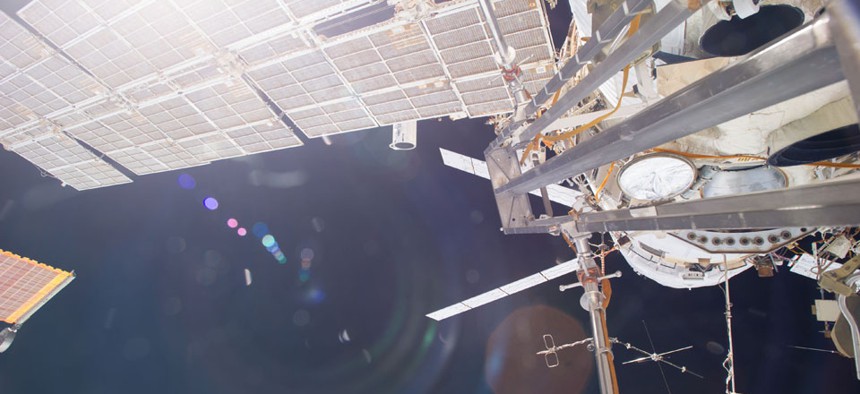
The ISS, with the European automated transfer vehicle Georges Lemaître docked, in October 2014. NASA/ESA
A Little Ship Just Saved the International Space Station
Meet the Georges Lemaître, which helped the orbiting laboratory—currently home to six humans—to avoid a potentially disastrous collision with space junk.
In a week that seems to be at least partially dedicated to space movies, the International Space Station—and the six very real humans living within its confines—just had a Hollywood-worthy moment. In late October, the European Space Agency reports, the orbiting lab was threatened with a collision by space junk, in the manner of Gravity. It was saved by some quick-thinking people on Earth—and by a little space ship that happened to be, fortunately, docked to the station when the threat arose.
The trouble began back in 2009, Smithsonian Magazine notes, when a piece of the deactivated Russian Cosmos-2251 satellite slammed into a U.S. Iridium satellite. Normally, that wouldn't matter. The debris from that collision—like the other pieces of the space junk that are stuck in orbit around Earth—is generally harmless to the ISS. But it can also be—Gravity again—incredibly destructive when it happens to be on a collision course with a human-carrying spacecraft. (Even something as tiny as a fleck of paint, the ESA points out, can cause major damage—given that it travels at more than 17,000 miles an hour.) On Earth, ground stations are charged with tracking the space junk that whirls outside of Earth, charting its trajectories for potential collisions with the ISS.
And here's where things got scary. On October 27, a team of trackers detected a piece of Cosmos-2251—a piece, the ESA notes, only about the size of a human hand—that seemed to be on a collision course with the ISS. (Calculations suggested that the object would pass, the agency puts it, "within 4km—too close for comfort.")
This, in itself, was bad luck. But there was some further bad luck, too: There's a standard emergency maneuver designed for these situations that relies on Russia’s Progress supply ships. (This reliance was only possible after 2012; before then, "if an object was spotted within 24 hours of a potential strike the astronauts returned to their spacecraft, prepared for evacuation and hoped for the best.")
None of the resupply ships, however, were in harbor during the time of the near-collision. Oof.
Fortunately there was a little bit of good luck, too—actually, a lot of good luck. The ISS currently has a craft docked to it: the Automated Transfer Vehicle Georges Lemaître, which ferries supplies to the station from Earth. The unmanned ship, despite its current status as a mere appendage of the ISS, is also controllable from Earth. Which meant that a team of engineers on the ground were able to use the space ferry to help move the ISS out of harm's way.
Just six hours prior to the potential impact, at 17:42 GMT, the ATV Control Center team, based in Toulouse, France—but working with fellow engineers at control centers in Moscow and Houston—commanded a four-minute thruster burn. The force generated by that boost was enough to shift the course of the 463-ton Station by nearly a mile—and, as a result, to get it, and its residents, out of harm’s way.
It was a tricky maneuver, one that relied on precise calculations. The goal was to move the Station enough to get it out of the path of space debris ... but not enough to put it into a worse orbital location. And not enough, as well, to affect the Progress craft that would dock with the Station a couple days after the emergency maneuver was enacted. Then again, as the ESA flight director Jean-Michel Bois put it after an emergency had been avoided, "This is what the ATV Control Center team trains for."
All's well up in space, in other words, because of some quick-thinking humans and an obliging little spacecraft. As the ESA writes, "This is the first time the Station’s international partners have avoided space debris with such urgency."






